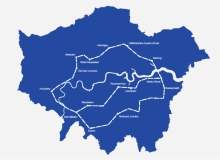

Located some 14 km east of Charing Cross, the London suburb of Barking could be best described as unassuming. While some of its most famous sons and daughters include musician Billy Bragg and writer Mary Wollstonecraft, recent years have seen the town become earmarked for both residential and commercial regeneration.
The fulcrum of these efforts has been a brown-field site, Barking Riverside – a 443-acre piece of land once occupied by the local power station – which was given planning permission in 2007 to create 10,800 new homes.
However, seven years later and building has stalled. Under the planning deal, as issued by the Greater London Authority, only 1,200 homes can be built until the area is better connected by public transport – particularly rail.
Could R25 make Barking the next Piccadilly Circus?
Known in the corridors of City Hall as R25, a new orbital railway being drawn up by London’s transport authorities would link up the city’s inner suburbs. Never one to shy away from hyperbole, Johnson said that the scheme would transform Barking into "Piccadilly Circus in 100 years’ time".
In July, London’s Mayor used the site as a bully pulpit to declare his London Infrastructure 2050 plan, estimated to cost nearly £1.3 trillion according to consultants Arup. Addressing the prediction that the capital’s population will swell to over eleven million within the next 35 years, Johnson claimed that roughly £200bn of spending on transport infrastructure would be required to maintain London’s top-tier city status.
Can skyscrapers and train stations really go together?

US Tariffs are shifting - will you react or anticipate?
Don’t let policy changes catch you off guard. Stay proactive with real-time data and expert analysis.
By GlobalDataSimilar to Tokyo’s Yamanote Line, which has become one of the city’s busiest and best-served train links since its construction in 1956, London’s new metro-style railway would form a loop around the city limits.
Blueprints released by City Hall also appear to share a direct correlation with the capital’s Overground network, which consists of 83 stations, stretching out into the Greater London area. Since its introduction in 2007, London Overground has seen passenger numbers quadruple, decongesting underground lines and engendering the regeneration of urban outposts in the process.
The mayor will surely leverage the successful example of the Overground to promote his new orbital railway. CityMetric, the data-driven website owned by the New Statesman, believes that Transport for London (TfL), would construct the services "using existing lines wherever possible", such as the Overground.
Comparing the plan to proposals for the Grand Paris Express – which could see four new orbital lines built in the French capital over the next two decades – CityMetric also speculates that expensive tunnelling would have to be undertaken on certain sections, including from Barking to Sidcup, south-east of London.

Exorbitant spending: Can London justify another infrastructure project?
While some have lauded the R25 concept in theory, most commentators have voiced concerns over costs. The primary question is, can London justify more transport infrastructure spending on the back of the £15m expenditure on Crossrail, which is pencilled in for completion in 2019?
That’s not to mention the other transport schemes Johnson is pushing, including a super-hub airport in the Thames Estuary, inner-city tunnelled roads and Crossrail 2 – an extension between Surrey and Hertfordshire, which he claims could be up and running by 2029, to the tune of £16bn.
According to Christian Wolmar, one of Britain’s foremost transport commentators, the mayor simply has too many irons in the infrastructure fire, with seemingly scant consideration of expenditure.
"This announcement is typical of a Boris initiative, a brash idea that is suddenly produced out of the hat with no context, no genuine plan of how to achieve it and no assessment of whether it is the right idea," he said. "Trams, for example, may be a cheaper and more viable alternative. Boris in the past has talked about a new airport, bridges, roads in tunnels, cycle routes in the sky, and now we have an orbital railway without any thought that, actually, London can probably do some of these things, but not all of them."
Wolmar’s viewpoint is also shared by Craig Carey-Clinch, managing director of policy consultancy Rowan Public Affairs.
"Eye-catching ideas such as an orbital railway are good as far as they go, but the cost and disruption during development would be considerable," he said. "Would such flagship ideas carry the value and benefits claimed, when inexpensive measures, such as supporting motorcycling alongside cycling, as commuter transport carry much clearer and more immediate value and benefit for London’s commuters?"
Stick with what you’ve got: Leveraging the Overground might be more efficient
One rail network project Johnson has vociferously denounced has been HS2, the controversial plan to link London, the Midlands and the Northwest via a high-speed railway. Amid claims that taxpayers may have to foot up to £80bn of its construction – if ratified – can plans for an orbital railway really be legitimised?
At present, the answer seems to be ‘no’. Given its success thus far, it might be wiser for London’s transport authorities to inject further investment in the existing Overground. It is also unlikely that Londoners will be patient for another infrastructure project that could take decades to bring to life.
As Labour MP for Tooting, Sadiq Khan, said in response to the launch of London Infrastructure 2050: "these are real challenges facing Londoners today; not in 2050."



